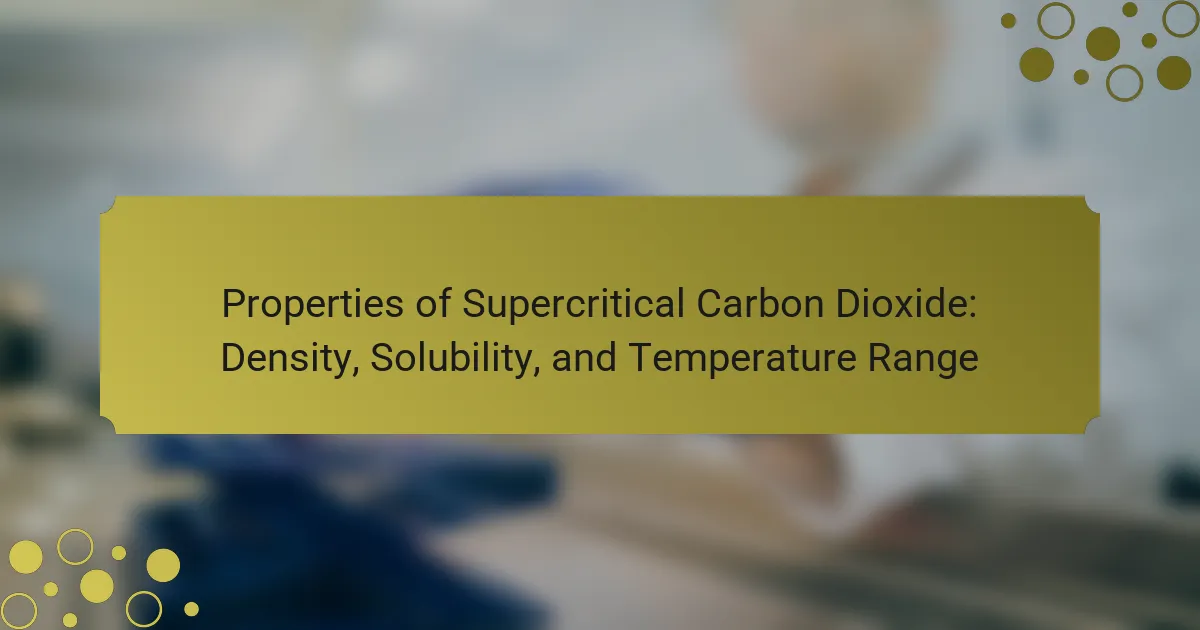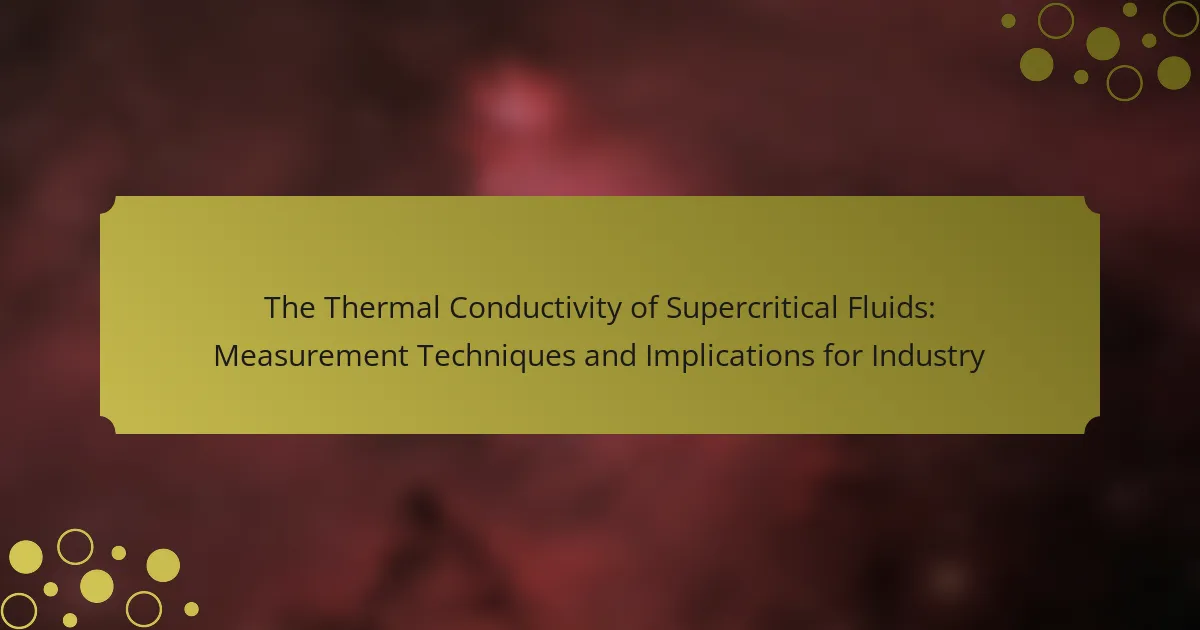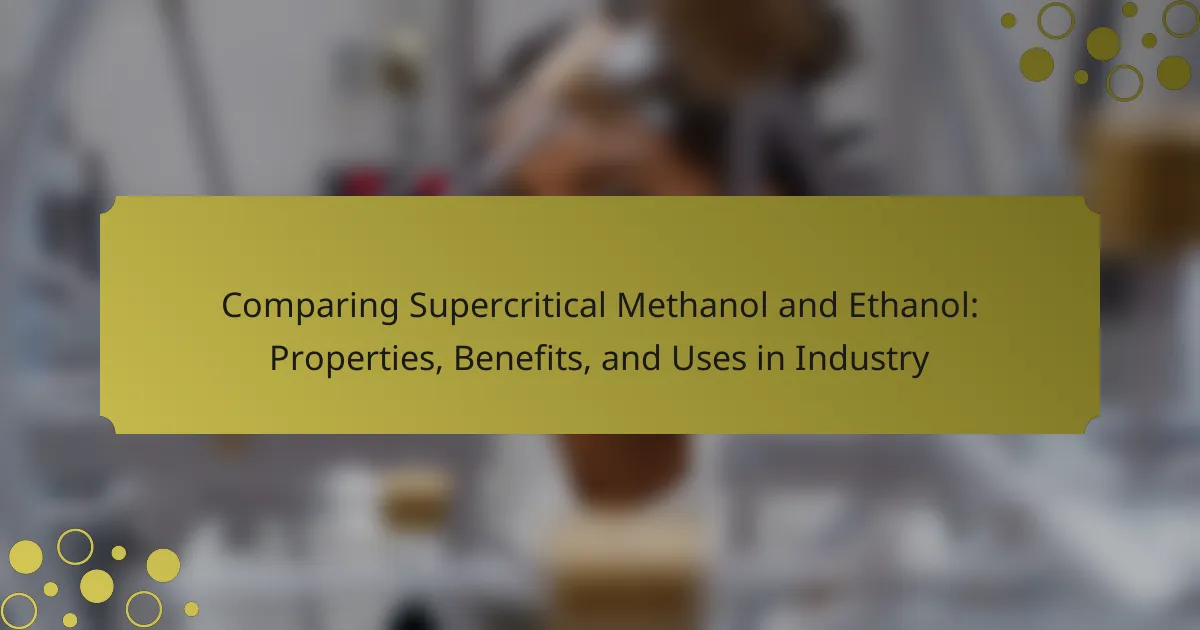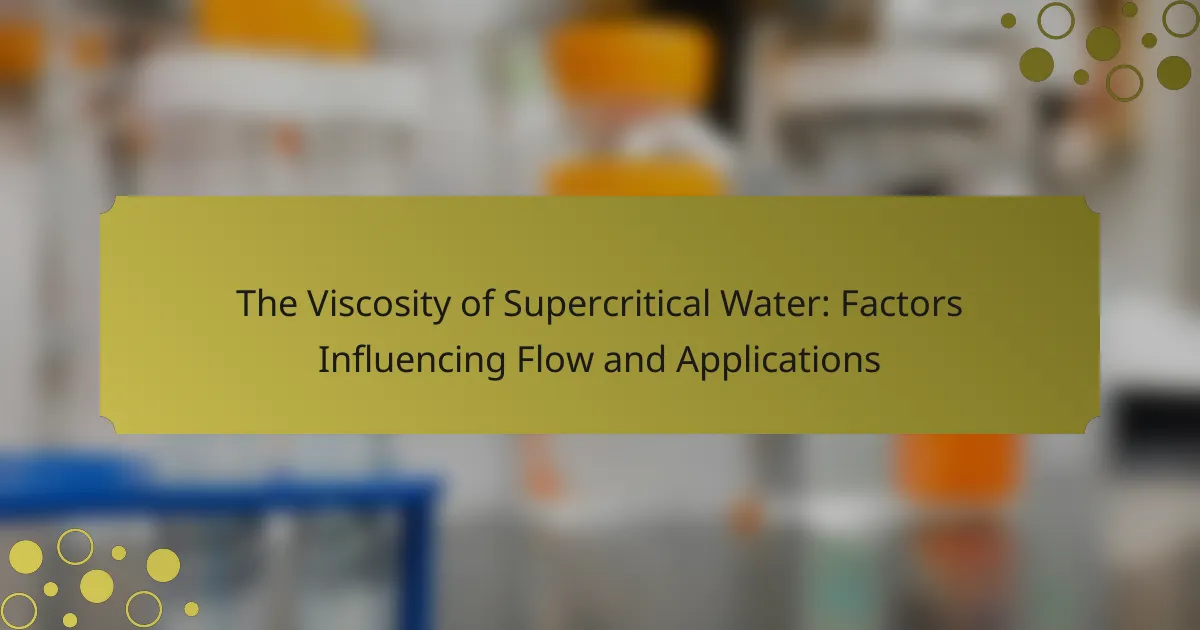Supercritical fluids are substances that exist above their critical temperature and pressure, exhibiting properties of both liquids and gases. This article explores how supercritical fluids, particularly supercritical carbon dioxide, enhance chemical reactions by improving reaction rates and selectivity. It discusses the influence of temperature and pressure on the behavior of supercritical fluids, highlighting their ability to increase solubility and kinetic energy, thereby optimizing reaction efficiency. Additionally, the article presents research findings that demonstrate significant enhancements in reaction rates and yields when using supercritical fluids compared to conventional solvents, particularly in industries such as pharmaceuticals and materials science.
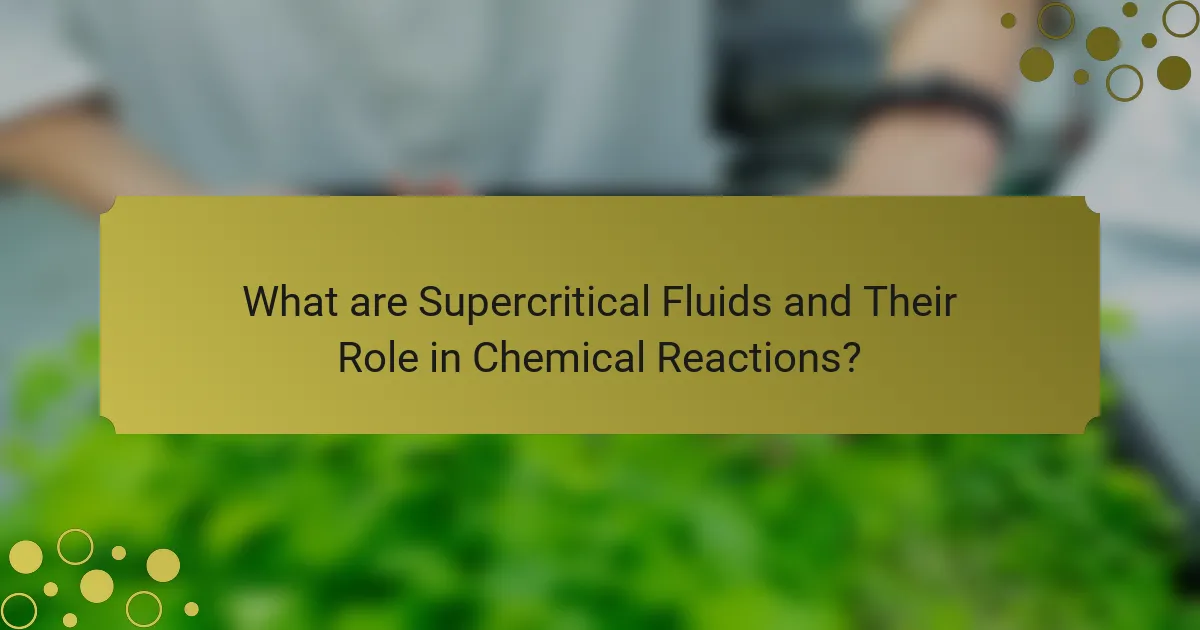
What are Supercritical Fluids and Their Role in Chemical Reactions?
Supercritical fluids are substances that exist at a temperature and pressure above their critical point. In this state, they exhibit properties of both liquids and gases. Supercritical fluids can dissolve materials like gases and have low viscosity like gases. This unique combination allows them to penetrate materials effectively.
In chemical reactions, supercritical fluids enhance reaction rates and selectivity. For instance, supercritical carbon dioxide is widely used as a solvent in extraction processes. Its ability to dissolve non-polar compounds makes it valuable in industries like pharmaceuticals.
Research shows that supercritical fluids can significantly reduce reaction times. A study published in the Journal of Supercritical Fluids demonstrated that reactions in supercritical fluids can occur at lower temperatures compared to traditional methods. This efficiency can lead to energy savings and reduced by-products.
How do supercritical fluids differ from gases and liquids?
Supercritical fluids differ from gases and liquids in their unique physical properties. Supercritical fluids exist above their critical temperature and pressure, where distinct liquid and gas phases cease to exist. They exhibit gas-like diffusion and liquid-like density. This allows supercritical fluids to dissolve substances more effectively than gases or liquids. For example, supercritical carbon dioxide can extract compounds from plants more efficiently than traditional solvents. Additionally, supercritical fluids can penetrate porous materials better than gases. Their unique properties make them valuable in various chemical processes, including extraction and reaction media.
What are the defining characteristics of supercritical fluids?
Supercritical fluids are substances that exist above their critical temperature and pressure. In this state, they exhibit properties of both liquids and gases. Supercritical fluids have high density, which allows them to dissolve substances effectively. They also have low viscosity, enabling them to diffuse rapidly. Their solvent power can be tuned by adjusting temperature and pressure. Supercritical fluids can enhance reaction rates in chemical processes. Carbon dioxide is a common example, used for extraction and reactions. These characteristics make supercritical fluids valuable in various industrial applications.
Why are temperature and pressure critical in defining supercritical fluids?
Temperature and pressure are critical in defining supercritical fluids because they determine the state of the substance. A supercritical fluid exists above its critical temperature and pressure. At this state, the fluid exhibits properties of both liquids and gases. The critical temperature is the maximum temperature at which a substance can exist as a liquid. The critical pressure is the minimum pressure required to maintain this liquid state. When both conditions are met, the substance can dissolve materials like a liquid and diffuse like a gas. This unique behavior is essential in various applications, including extraction and chemical reactions.
What advantages do supercritical fluids offer in chemical reactions?
Supercritical fluids offer several advantages in chemical reactions. They provide enhanced solubility for reactants, which can lead to increased reaction rates. Supercritical fluids also enable improved mass transfer, facilitating the mixing of reactants. Their tunable properties allow for precise control over temperature and pressure, optimizing reaction conditions. Additionally, supercritical fluids can act as environmentally friendly solvents, reducing the need for hazardous organic solvents. Research indicates that reactions in supercritical carbon dioxide can achieve higher yields compared to traditional solvents. These factors contribute to the efficiency and sustainability of chemical processes.
How do supercritical fluids enhance reaction rates?
Supercritical fluids enhance reaction rates by increasing solubility and diffusion of reactants. In a supercritical state, fluids exhibit unique properties that combine gas-like and liquid-like characteristics. This leads to improved mass transfer between phases, facilitating faster reactions. The high density of supercritical fluids allows for greater reactant concentration. Additionally, their low viscosity enhances the mobility of molecules. Studies show that reactions in supercritical fluids can occur at lower temperatures compared to traditional solvents. This reduces energy consumption and can lead to higher yields. For example, supercritical carbon dioxide has been used effectively in extraction processes, demonstrating its efficiency in enhancing reaction rates.
What are the environmental benefits of using supercritical fluids?
Supercritical fluids offer several environmental benefits. They can reduce the use of harmful solvents in chemical processes. This leads to less toxic waste generation. Supercritical fluids also enhance energy efficiency in extraction processes. They often operate at lower temperatures, minimizing energy consumption. Additionally, they can improve the selectivity of reactions, reducing by-products. This results in a cleaner production process. Studies show that using supercritical carbon dioxide can decrease greenhouse gas emissions. Overall, supercritical fluids contribute to more sustainable chemical practices.
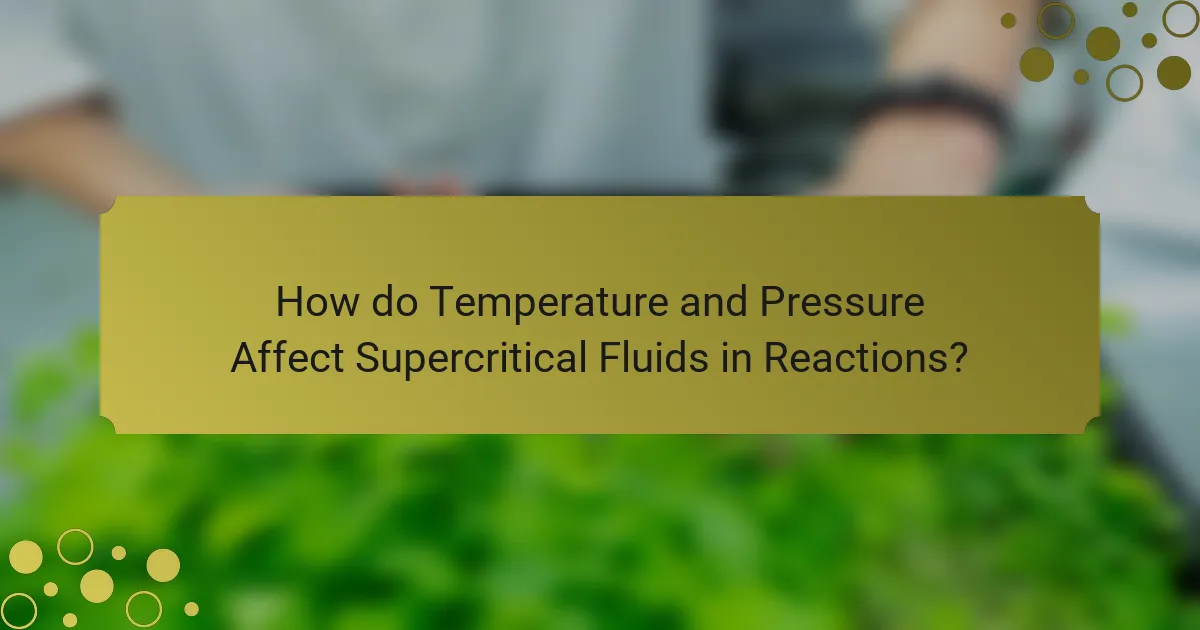
How do Temperature and Pressure Affect Supercritical Fluids in Reactions?
Temperature and pressure significantly influence the behavior of supercritical fluids in chemical reactions. Increasing temperature typically enhances the solubility of reactants in supercritical fluids. Higher temperatures also increase the kinetic energy of molecules, leading to faster reaction rates. Conversely, pressure impacts the density of supercritical fluids. Increased pressure raises the density, which can enhance the interaction between reactants. This can result in improved reaction efficiency. For example, carbon dioxide at supercritical conditions can dissolve organic compounds effectively, facilitating reactions. Studies show that adjusting these parameters can optimize yields in various chemical processes.
What is the relationship between temperature and pressure in supercritical fluids?
In supercritical fluids, temperature and pressure are interrelated in determining their properties. Increasing temperature generally raises the fluid’s density, while pressure influences the fluid’s phase behavior. As pressure increases, the temperature at which the fluid becomes supercritical also rises. This means that at higher pressures, a higher temperature is required to maintain the supercritical state. For example, carbon dioxide becomes supercritical at approximately 31°C and 73.8 bar. Understanding this relationship is crucial for optimizing chemical reactions in supercritical fluids, as it affects solubility and reaction rates.
How does varying temperature influence the properties of supercritical fluids?
Varying temperature significantly influences the properties of supercritical fluids. As temperature increases, the density of supercritical fluids typically decreases. This change in density affects solubility and mass transfer rates. Higher temperatures can enhance the diffusivity of supercritical fluids. Enhanced diffusivity improves reaction rates in chemical processes. Additionally, temperature variations can alter the viscosity of supercritical fluids. Lower viscosity at higher temperatures facilitates better flow characteristics. Studies indicate that optimal temperature control is crucial for maximizing efficiency in supercritical fluid applications.
What impact does pressure have on the solubility of reactants in supercritical fluids?
In supercritical fluids, increasing pressure enhances the solubility of reactants. This occurs because higher pressure increases the density of the supercritical fluid. As density rises, the solvent’s ability to dissolve solutes improves. The enhanced solvation leads to increased interaction between reactants. Studies show that solubility can increase significantly with pressure adjustments. For instance, carbon dioxide’s solubility in supercritical conditions can double with a pressure increase of just a few hundred atmospheres. Consequently, optimizing pressure in supercritical fluid processes can improve reaction efficiency and yield.
How can temperature and pressure be optimized in chemical reactions using supercritical fluids?
Temperature and pressure can be optimized in chemical reactions using supercritical fluids by adjusting their conditions to enhance solubility and reaction rates. Supercritical fluids exhibit unique properties at critical temperature and pressure, allowing for better mass transfer and reaction kinetics. By fine-tuning the temperature, one can achieve a balance between increased solubility of reactants and maintaining reaction rates. Increasing pressure generally enhances solubility, which can lead to higher reaction yields. Studies have shown that specific temperature and pressure ranges for supercritical CO2 can significantly improve reaction efficiency. For example, reactions conducted at temperatures around 40-60°C and pressures of 1000-3000 psi have demonstrated optimal performance in various applications.
What techniques are used to control temperature and pressure in experiments?
Techniques used to control temperature and pressure in experiments include the use of thermostats, pressure regulators, and environmental chambers. Thermostats maintain a specific temperature by activating heating or cooling elements. Pressure regulators ensure a constant pressure by adjusting the flow of gases or liquids. Environmental chambers create controlled atmospheres for experiments, allowing precise manipulation of both temperature and pressure. Additionally, feedback control systems monitor real-time data to adjust conditions automatically. These techniques are essential for reproducibility in experiments involving supercritical fluids, where specific temperature and pressure conditions significantly influence reaction rates.
How do optimal conditions vary for different chemical reactions?
Optimal conditions for chemical reactions vary based on the specific reactants and products involved. Each reaction has unique temperature and pressure requirements for optimal performance. For example, some reactions require high temperatures to overcome activation energy barriers. Others may proceed more efficiently at lower temperatures to prevent unwanted side reactions.
Pressure also plays a critical role. Gas-phase reactions often benefit from increased pressure, which can enhance reaction rates by increasing reactant concentration. Conversely, liquid-phase reactions may not show significant changes with pressure adjustments.
Additionally, catalysts can modify optimal conditions by lowering activation energy, allowing reactions to occur more readily under milder conditions. The presence of solvents can further influence reaction dynamics, impacting solubility and reactivity.
Overall, the interplay of these factors creates a complex landscape for optimizing chemical reactions, emphasizing the need for tailored conditions based on specific reaction characteristics.
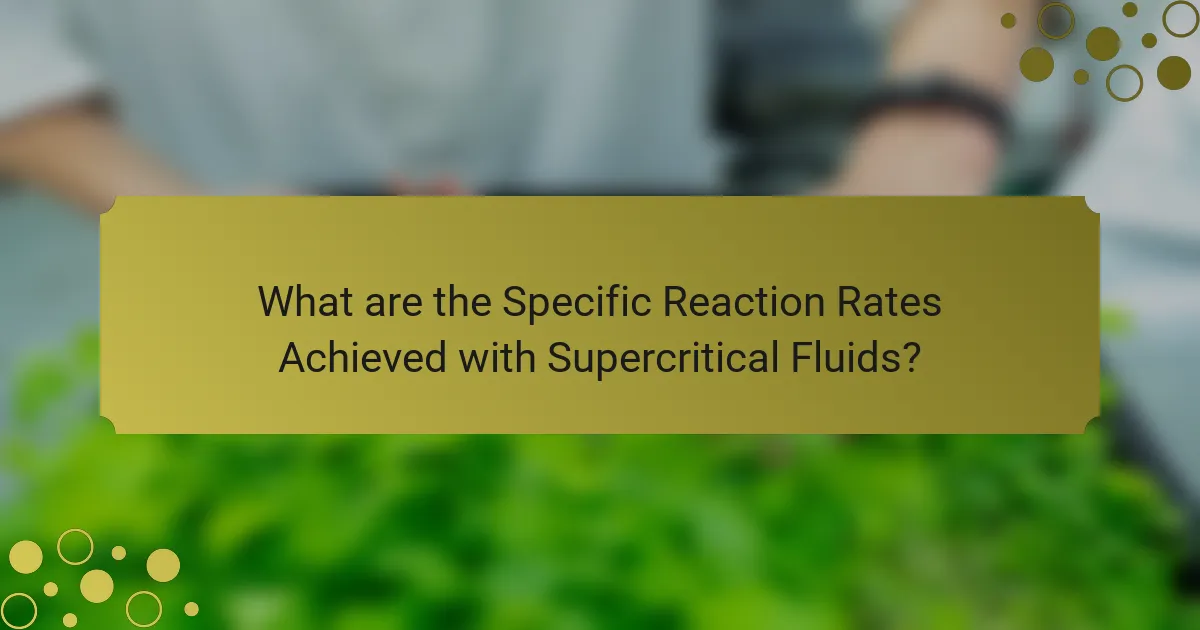
What are the Specific Reaction Rates Achieved with Supercritical Fluids?
Specific reaction rates achieved with supercritical fluids can be significantly enhanced compared to conventional solvents. For example, reaction rates can increase by several orders of magnitude. This enhancement occurs due to the unique properties of supercritical fluids, including increased diffusivity and reduced viscosity.
Research indicates that reaction rates can be up to 10 to 100 times faster in supercritical carbon dioxide compared to liquid solvents. The ability to tune temperature and pressure allows for optimal reaction conditions. Additionally, supercritical fluids can dissolve a wide range of reactants, promoting better interaction.
Studies have shown that supercritical fluid extraction processes can achieve high yields and selectivity. This is particularly beneficial in fields such as pharmaceuticals and materials science. Overall, the specific reaction rates achieved with supercritical fluids demonstrate their effectiveness in accelerating chemical reactions.
How do supercritical fluids influence the kinetics of chemical reactions?
Supercritical fluids enhance the kinetics of chemical reactions by providing unique solvent properties. They exhibit increased diffusivity compared to liquids, which facilitates faster molecular interactions. Supercritical fluids also allow for higher solubility of reactants, promoting greater reaction rates. The tunable density of supercritical fluids can optimize reaction conditions, influencing activation energy. Research indicates that reactions in supercritical carbon dioxide can proceed significantly faster than in traditional solvents. For instance, studies show that reaction rates can increase by several orders of magnitude in supercritical conditions. This enhancement is due to the fluid’s ability to dissolve both polar and nonpolar substances effectively. Thus, supercritical fluids play a crucial role in accelerating chemical kinetics.
What role do molecular interactions play in reaction rates?
Molecular interactions significantly influence reaction rates by affecting the frequency and energy of collisions between reactants. Stronger interactions can lead to more effective collisions, increasing the likelihood of reaction. Conversely, weaker interactions may reduce the rate of reaction due to fewer successful collisions. For example, in supercritical fluids, the density and solvent properties enhance molecular interactions. This environment allows for greater molecular mobility, which can accelerate reaction rates compared to traditional solvents. Studies show that reaction rates can increase dramatically in supercritical conditions due to these enhanced interactions.
How do supercritical fluids compare to traditional solvents in terms of reaction rates?
Supercritical fluids generally enhance reaction rates compared to traditional solvents. This is due to their unique properties, such as low viscosity and high diffusivity. These characteristics facilitate faster molecular interactions. In many cases, supercritical fluids can dissolve reactants more effectively than conventional solvents. Research shows that reactions in supercritical carbon dioxide can occur up to ten times faster. This speed is attributed to the increased solvation power and reduced mass transfer limitations. Studies indicate that supercritical fluids can also alter reaction pathways, leading to higher yields. Overall, supercritical fluids provide a more efficient medium for chemical reactions than traditional solvents.
What factors can limit the effectiveness of supercritical fluids in reactions?
Factors that can limit the effectiveness of supercritical fluids in reactions include temperature, pressure, and solubility. Supercritical fluids require specific temperature and pressure conditions to maintain their state. Deviations from optimal conditions can lead to reduced reaction rates. Additionally, the solubility of reactants in the supercritical fluid affects the reaction efficiency. Low solubility can hinder reactant availability, limiting the reaction’s progress. The nature of the supercritical fluid itself can also influence reaction outcomes. For example, different solvents may have varying abilities to dissolve reactants or facilitate reactions. These factors collectively determine the overall effectiveness of supercritical fluids in chemical reactions.
What are common challenges faced when using supercritical fluids?
Common challenges faced when using supercritical fluids include high operational costs and complex equipment requirements. The necessity for precise temperature and pressure control adds to these costs. Additionally, the solubility of compounds can be unpredictable in supercritical fluids. This variability can affect reaction efficiency. Safety concerns also arise due to the high pressures involved. Furthermore, the scalability of processes using supercritical fluids can be difficult. These challenges necessitate careful consideration for practical applications in chemical reactions.
How can these challenges be addressed in experimental setups?
Challenges in experimental setups involving supercritical fluids can be addressed through careful control of temperature and pressure. Precise temperature regulation is essential for maintaining the supercritical state. Utilizing high-quality pressure vessels ensures stability during experiments. Incorporating real-time monitoring systems can help detect deviations in conditions. Additionally, optimizing solvent selection enhances reaction efficiency. Implementing robust safety protocols mitigates risks associated with high-pressure systems. Regular calibration of equipment contributes to accurate measurements. These strategies collectively improve the reliability of experimental outcomes in supercritical fluid research.
What best practices can be employed for utilizing supercritical fluids in chemical reactions?
Employing best practices for utilizing supercritical fluids in chemical reactions involves several key strategies. First, maintaining precise control over temperature and pressure is crucial. Supercritical fluids require specific conditions to achieve their unique properties. Second, selecting the appropriate solvent based on solubility and reaction compatibility enhances efficiency. Third, optimizing reaction times can significantly impact yield and quality. Fourth, utilizing high-pressure equipment designed for supercritical conditions ensures safety and reliability. Additionally, conducting thorough pre-experimental studies helps in understanding the reaction mechanism. Finally, continuous monitoring of reaction parameters allows for real-time adjustments, improving outcomes. These practices are supported by various studies emphasizing the importance of controlled environments in enhancing reaction efficacy.
Supercritical fluids are substances that exist above their critical temperature and pressure, displaying unique properties that combine characteristics of both liquids and gases. This article explores their significant role in enhancing chemical reactions, focusing on how temperature and pressure influence reaction rates and solubility. Key advantages of using supercritical fluids include improved mass transfer, reduced reaction times, and environmental benefits such as decreased reliance on hazardous solvents. Additionally, the article addresses the challenges faced in utilizing supercritical fluids and outlines best practices for optimizing their use in chemical processes.
